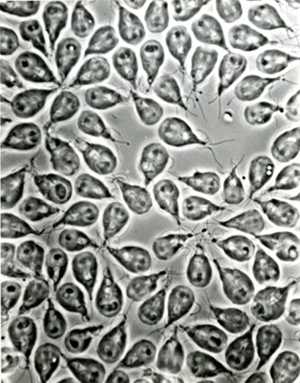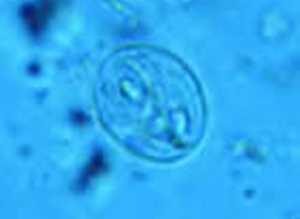Sources of Infection & Risk Factors
General Epidemiology

Giardia trophozoites. Credit: Waterborne Disease Prevention Branch, CDC
Giardiasis is a diarrheal illness caused by the parasite Giardia intestinalis (also known as Giardia lamblia or Giardia duodenalis). A parasite is an organism that feeds off of another to survive.
Giardiasis is a global disease. It infects nearly 2% of adults and 6% to 8% of children in developed countries worldwide. Nearly 33% of people in developing countries have had giardiasis. In the United States, Giardia infection is the most common intestinal parasitic disease affecting humans 1.
People become infected with Giardia by swallowing Giardia cysts (hard shells containing Giardia) found in contaminated food or water. Cysts are instantly infectious once they leave the host through feces (poop) 2. An infected person might shed 1-10 billion cysts daily in their feces (poop) and this might last for several months 2,6,7. However, swallowing as few as 10 cysts might cause someone to become ill 2,6. Giardia may be passed from person-to-person or even from animal-to-person 2,3. Also, oral-anal contact during sex has been known to cause infection 4,5. Symptoms of giardiasis normally begin 1 to 3 weeks after a person has been infected 6.
Giardia infection rates have been known to go up in late summer 8-10. Between 2006-2008 in the United States, known cases of giardiasis were twice as high between June-October as they were between January-March 2.
Anyone may become infected with Giardia. However, those at greatest risk are 2,11-16:

Wet mount of a Giardia cyst. Credit: Waterborne Disease Prevention Branch, CDC
- Travelers to countries where giardiasis is common
- People in childcare settings
- Those who are in close contact with someone who has the disease
- People who swallow contaminated drinking water
- Backpackers or campers who drink untreated water from lakes or rivers
- People who have contact with animals who have the disease
- Men who have sex with men
The risk of humans acquiring Giardia infection from dogs or cats is small 17-19,13. The exact type of Giardia that infects humans is usually not the same type that infects dogs and cats 17,18,13.
Learn more about Giardia and pets.
Molecular Characterization
Giardia intestinalis (aka: G. duodenalis, G. lamblia) can be subdivided based on molecular analysis into what are known as different genetic assemblages (A,B,C,D,E,F, and G). Some of these assemblages can be classified even further into subtypes like for example A-I, A-II, A-III, A-IV. Each assemblage is capable of infecting certain species, and some assemblages are more commonly seen than others 18,20,21.
| Molecular Characterization | |
|---|---|
| Assemblages | Some Species Commonly Infected |
| A-I | Humans and animals (cats, dogs, livestock, deer, muskrats, beavers, voles, guinea pigs, ferrets) |
| A-II | Humans (more common than A-I) |
| A-III and A-IV | Exclusively animals |
| B | Humans and animals (livestock, chinchillas, beavers, marmosets, rodents) |
| C and D | Dogs, coyotes |
| E | Alpacas, cattle, goats, pigs, sheep |
| F | Cats |
References
- Kappus KD, Lundgren RG, Jr., Juranek DD, Roberts JM, Spencer HC. Intestinal parasitism in the United States: update on a continuing problem. Am J Trop Med Hyg. 1994;50(6):705-13.
- CDC. Giardiasis surveillance - United States, 2006-2008. MMWR Morb Mortal Wkly Rep. 2010;59(SS06):15-25.
- Robertson LJ, Hanevik K, Escobedo AA, Morch K, Langeland N. Giardiasis--why do the symptoms sometimes never stop? Trends Parasitol. 2010;26(2):75-82.
- Escobedo AA, Cimerman S. Giardiasis: a pharmacotherapy review. Expert Opin Pharmacother. 2007;8(12):1885-1902.
- Pakianathan MR, McMillan A. Intestinal protozoa in homosexual men in Edinburgh. Int J STD AIDS. 1999;10(12):780-4.
- Rendtorff RC. The experimental transmission of human intestinal protozoan parasites. II. Giardia lamblia cysts given in capsules. [PDF - 12 pages] Am J Hyg. 1954;59(2):209-20.
- Danciger M, Lopez M. Numbers of Giardia in the feces of infected children. Am J Trop Med Hyg.1975;24(2):237-42.
- Naumova EN, Jagai JS, Matyas B, DeMaria A, Jr., MacNeill IB, Griffiths JK. Seasonality in six enterically transmitted diseases and ambient temperature. Epidemiol Infect. 2007;135(2):281-92.
- Naumova EN, Chen JT, Griffiths JK, Matyas BT, Estes-Smargiassi SA, Morris RD. Use of passive surveillance data to study temporal and spatial variation in the incidence of giardiasis and cryptosporidiosis. Public Health Rep. 2000;115(5):436-47.
- Greig JD, Michel P, Wilson JB, Lammerding AM, Majowicz SE, Stratton J, Aramini JJ, Meyers RK, Middleton D, McEwen SA. A descriptive analysis of giardiasis cases reported in Ontario, 1990-1998. Can J Public Health. 2001;92(5):361-5.
- Thompson RC. Giardiasis as a re-emerging infectious disease and its zoonotic potential. Int J Parasitol. 2000;30(12-13):1259-67.
- Birkhead G, Vogt RL. Epidemiologic surveillance for endemic Giardia lamblia infection in Vermont. The roles of waterborne and person-to-person transmission. 1989;129(4):762-8.
- Hoque ME, Hope VT, Scragg R, Kjellstrom T, Lay-Yee R. Nappy handling and risk of giardiasis. Lancet. 2001;357(9261):1017-18.
- Esfandiari A, Swartz J, Teklehaimanot S. Clustering of giardiasis among AIDS patients in Los Angeles County. Cell Mol Biol (Noisy-le-grand). 1997;43(7):1077-83.
- Welch TP. Risk of giardiasis from consumption of wilderness water in North America: a systematic review of epidemiologic data. Int J Infect Dis. 2000;4(2):100-3.
- Stuart JM, Orr HJ, Warburton FG, Jeyakanth S, Pugh C, Morris I, Sarangi J, Nichols G. Risk factors for sporadic giardiasis: a case-control study in southwestern England. Emerg Infect Dis. 2003;9(2):229-33.
- Berrilli F, Di Cave D, De Liberato C, Franco A, Scaramozzino P, Orecchia P. Genotype characterisation of Giardia duodenalis isolates from domestic and farm animals by SSU-rRNA gene sequencing. Vet Parasitol. 2004;122:193-9.
- Feng Y, Xiao L. Zoonotic potential and molecular epidemiology of Giardia species and giardiasis. Clin Microbiol Rev. 2011;24(1):110-40.
- The Merck Veterinary Manual. Overview of giardiasis. United States: Merck; 2013.
- Ballweber LR, Xiao L, Bowman D, Kahn G, Cama VA. Giardiasis in dogs and cats: update on epidemiology and public health significance. Trends Parasitol. 2010;26(4):180-9.
- Xiao L, Fayer R. Molecular characterisation of species and genotypes of Cryptosporidium and Giardia and assessment of zoonotic transmission. Int J Parasitol. 2008;38:1239–55.
- Page last reviewed: July 21, 2015
- Page last updated: July 21, 2015
- Content source:


 ShareCompartir
ShareCompartir